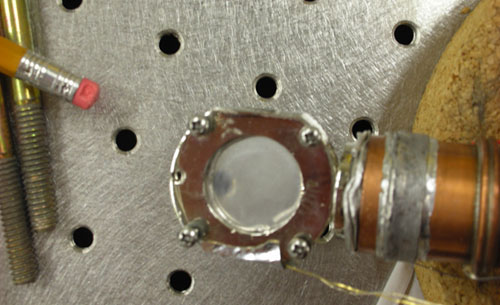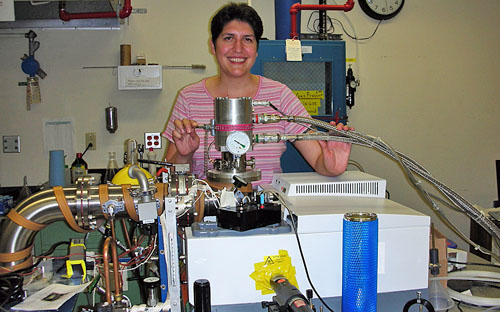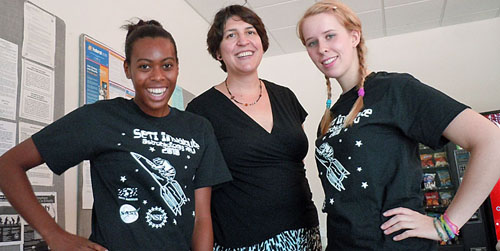By Dr. Rachel Mastrapa; Carl Sagan Center for the Study of Life in the Universe, SETI Institute, and Gail Jacobs
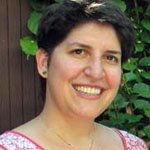 Rachel Mastrapa studies the surface processes of icy Solar System bodies by interpreting their infrared spectra. The majority of her work involves performing the ground truth measurements in the laboratory including calculating the complex indices of refraction of single composition ice samples. These measurements are then used to construct model spectra to interpret the chemical composition of observed spectra. She also studies the subtle changes seen in ice mixtures that are not seen in single composition samples. Rachel has collaborated with her peers to collect spectra of Europa from the Keck Observatory and interpret Cassini VIMS spectra of Enceladus.
Rachel Mastrapa studies the surface processes of icy Solar System bodies by interpreting their infrared spectra. The majority of her work involves performing the ground truth measurements in the laboratory including calculating the complex indices of refraction of single composition ice samples. These measurements are then used to construct model spectra to interpret the chemical composition of observed spectra. She also studies the subtle changes seen in ice mixtures that are not seen in single composition samples. Rachel has collaborated with her peers to collect spectra of Europa from the Keck Observatory and interpret Cassini VIMS spectra of Enceladus.
Click on images for larger view
Rachel, do you recall what first sparked your interest in science?
I can't remember a time when I wasn't interested in science. Ever since I was very young, I was curious. My mom tells me I used to have a big collection of sticks and stones. Maybe that's what led to my interest in Earth Sciences.
I excelled at math and science, and I loved participating in science fairs. It was frustrating because I was interested in astronomy, but coming up with astronomy projects wasn't easy in grade school. I was always doing random projects in completely different areas. In college, I narrowed my interest in astronomy when I took some classes in Earth Sciences. That's when I discovered that I wanted to pursue Planetary Science.
Briefly describe your research project.
Basically, my work involves doing ground truth measurements for ices in the Solar System. Doing ground truth measurements is a complex process. If we wanted to know what components made up an icy area on Earth, we'd just get a scoop of it, take it to the lab, and conduct several measurements to determine its contents. But these icy Solar System bodies are billions of miles away, so all we can do is use data gathered from ground-based telescopes or spacecraft, such as Galileo, Cassini or New Horizons, which is currently on its way to Pluto.
These spacecraft not only have on-board cameras that take pictures of the visible light; but they also carry spectrometers that break light up into many wavelengths and collect spectra, specifically in the infrared. Using this data, I can then measure the infrared spectrum of these ices in the lab for comparison to these observations. It's interesting to look at different wavelengths because molecules will absorb light at very specific wavelengths, and those absorptions are unique to specific compositions, such as water.
This picture from the lab shows the sample window (without ice). The sample is deposited on the clear window inside the metal ring. This is generally inside the sample chamber and isn't visible. It is only pulled out to clean it or check the temperature connections.
The measurements done in the lab help us analyze the remote observation data. Using this remote sensing data, I make a sample of ice under conditions that exist in the outer Solar System, such as on the surface of Europa, Enceladus, or a trans-Neptunian object. There are several different compositions of ice. Primarily water ice is in the Solar System, but it can also include methane, ethane, carbon dioxide, carbon monoxide, and methanol. I've worked with all of these different ices in the laboratory. The main conditions I can simulate in the lab are the low temperatures and pressures similar to the vacuum in space. I'm looking for ices in the general temperature range within the Solar System -- anywhere from the low 20s in Kelvin up to 150 Kelvin. My sample chamber can reach a bottom temperature of 15 Kelvin (-258 degrees Celsius; -432.67 degrees Fahrenheit).
What is the coolest thing about your project?
It's really fun learning about the composition and structures of ices that are billions of miles away. But my work takes that one step further. There are still some observations that have absorptions that are not identified. We either haven't made the comparison yet or it's non-unique; it could be several different materials. Most of the icy objects we've observed are mainly water. As we get further out, the objects are mostly nitrogen and methane dominated.
There is another layer of interpretation that we can take from infrared spectroscopy, however, and this has been the bulk of my work recently. My team and I are not just identifying pure compounds but we're also seeing how those absorptions change as a function of temperature and mixing materials together. Mixing different materials together can shift where the absorptions are, sometimes making them stronger or weaker, making them go away, or making new absorptions appear. By using the infrared spectrum, we can identify not only what materials are on the surface, but we can (a) possibly get a remote measurement of the temperature of the surface, and (b) get an idea of how the materials are separated or mixed together, and that's really interesting.
It's also cool working in the Astrophysics & Astrochemistry Laboratory at NASA Ames Research Center. Many of these measurements have never been done before. It's not easy to put these labs together and keep them working, and it can be challenging to make the samples. It's a lot of fun to get in the lab and do the hands-on work!
Rachel Mastrapa working in the laboratory.
Is your research hindered by existing techniques or technology?
When I think about my biggest challenges, the first thing that comes to my mind is just finding the time to pursue all the projects in which I'm interested. But the techniques we use today in making the samples can also be challenging. We're often limited in the laboratory because it's difficult and expensive to build a laboratory system that can do multiple measurements. Typically we can make one type of sample or one type of measurement. In my dream world, I'd have a laboratory system with all kinds of instruments so I could better characterize my samples. I don't waste much time thinking about what I don't have, however; there's a lot to do now with the lab equipment I do have access to.
Why should the general public care about your research?
Some of these measurements have simply never been done before. My research is the most basic groundwork for future exploration. Some day, far into the future when humans are at the outer edges of the Solar System, they'll know what those planetary bodies are made of because of the work my colleagues and I have done. Our groundwork might one day lead to locating resources, finding where the hot spots are on the surfaces that have oceans, finding if you can remotely detect the temperature of these surfaces, and even possibly finding evidence of life on these other objects.
Essentially, the methods I'm working out right now will be the basis for future discoveries. In the Star Trek TV series, someone may refer to a "Class M" planet. They know it's a Class M planet because they did some kind of scan on it and their software contains algorithms that are based on research someone else did a hundred years earlier -- and I'm the person doing those measurements now.
What keeps you motivated?
Solving problems! I like finding a question or problem and then trying to figure out an answer or solution. One of the challenging parts of my work is getting the samples just right, but it's also interesting to think about why it's so challenging - what's going on. I like working in the lab and trying out different options to see how things work and finding ways to get the best sample I can - that's a lot of fun!
I also enjoy working in the lab with my students and post-docs. They tell me about a problem and I can offer suggestions, so the years of trial and error are paying off!
Rachel with two REU (Research Experience for Undergraduates) students she worked with in 2010. Left to right: Ashley Curry, Rachel Mastrapa, Janine Myszka.
Photo taken by Rachel's daughter, Helen
What was your dream job as a child?
I wanted to be a ballerina, then a veterinarian, then an astronaut, and finally an astronomer - in that order. I wrote a poem about stars when I was eight, which is when I think I first made my choice and knew what I wanted to do.
Do you speak with youth about your career; and if so, what advice do you offer?
I've been working with Project Astro for two years now. Project Astro is a national program that has a local node in the Bay Area. Its purpose is to do public outreach, partnering astronomers with educators. It emphasizes offering repeat visits with the same class so there is consistency and the children can follow up on questions with the same astronomer. This year I'll be visiting a third-grade class again. Project Astro has all the education materials set up so I just go in and talk about the phases of the moon, which is what they'll be studying. I do a variety of activities, from giving them lectures to an interactive, hands-on project. I like to show the kids that science can be a lot of fun.
I've also sat on various panels, including working with high school students. My main advice for them is to pursue a career they will actually enjoy doing and to not select a major simply because it's what their parents want. I tell them to play to their strengths. But the most important thing I let them know is to not be afraid to fail. A lot of people get hung up on the idea that failure is a bad thing. Failure is often a very good; you can learn a lot from your mistakes - especially in the sciences. There is a massive concern that failure means you're a loser, and I'd like to help dispel that myth.
Have you come across misconceptions about science or scientists to which you'd like to comment?
I often come across people who aren't aware of how collaborative science really is. I work with a group of fantastic people. We talk about our ideas with each other, we share our problems in the laboratory, and we help each other find solutions.
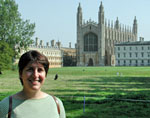 Scientists can have a reputation for being social outcasts and nerds who are incapable of talking with people, but science is generally very social. That's why the meetings we attend are so important. This is where we share ideas and talk to each other about the kinds of measurements and observations we are doing. Even people who are coming into science aren't fully aware of how important it is to interact with other scientists. (Photo to left: Rachel attending the American Astronomical Society's DPS [Division for Planetary Sciences] meeting in Cambridge, England.)
Scientists can have a reputation for being social outcasts and nerds who are incapable of talking with people, but science is generally very social. That's why the meetings we attend are so important. This is where we share ideas and talk to each other about the kinds of measurements and observations we are doing. Even people who are coming into science aren't fully aware of how important it is to interact with other scientists. (Photo to left: Rachel attending the American Astronomical Society's DPS [Division for Planetary Sciences] meeting in Cambridge, England.)
Written and oral communication skills are also very important. Going through peer reviews can be tough, and you have to have thick skin when you are answering questions or getting criticism at a presentation. People can be very confrontational and you have to be ready for that. I was lucky because when I was growing up, my older brother would play pranks on me and tell me crazy stories like chocolate milk came from brown cows. I tweeted a while back that I can accredit the vast majority of my scientific skepticism and possibly my thick skin to my older brother.
You have been involved in several organizations related to women in science. Why is this important to you?
In the United States, more women are now in the sciences at the undergraduate level and graduate levels, which is great. (See the Association of Women in Science website for the data.) But somewhere around the post-doc to professional scientist level, something happens which studies refer to as the "leaky pipeline." For a long time, it was explained as a lag effect because there weren't a lot of women to begin with in the sciences. But there has been steady increase towards parity at the undergraduate and graduate levels for about 20 years now. Yet at the post-doc and especially the faculty levels, the number of women in science and technology is pathetically low. This is particularly true in the "hard" sciences, such as physics and math. Less that 20% of tenured and tenure-track faculty are women and only 5-10% of full professors are women.
Many people have been looking into this issue of women in science. Some believe women are just not as good in science, but most studies indicate cultural effects. In one example, a recent study examined reference letters for tenure-track faculty positions. Mock panels from actual university departments were given typical reference letters. Statistically, it was much more common for women to be described as thoughtful, caring, helpful, working well in a team, and so on; while men were likely to be described as go-getters, independent, and on the cutting-edge of the field. The latter descriptors were more positively received, and the qualities such as working well in a team were not well received. Members of the science community need to think carefully when writing and reading recommendation letters.
While the situation for women is far better than it used to be, there is plenty of room for improvement. I can't imagine how difficult it was for the women who were the real pioneers in the sciences when there simply were no women in the field. I appreciate them blazing that trail for me. I've had my own challenges but I've been able to learn from them, and I'm very happy to be able to pass that experience down and help out the next generation. That's one of the reasons I believe the time I devote to these organizations is worthwhile.
As a working mom, do you have any advice for other women?
There is no perfect solution - there is only a perfect solution for you. You'll learn that you have some biases you weren't aware of in your decision-making. Getting past those biases will be the most helpful thing you can do. It's the "never's" that will be a challenge. Some moms say, "I would never put my child in full-time daycare." And then you realize you're losing your mind when you're at home full time so you put your child in full-time daycare or you get a full-time nanny. Or vice versa, you might say, "I would never quit work and stay at home," but being away from your child might just be destroying you -- and you're surprised by this. Go ahead and quit or cut back your hours and only work part time. You're not a failure if you do that.
The trailblazers did a fantastic job of getting us into the professional realms; but if anything, we're being destroyed by our own expectations of ourselves. We're supposed to work full time, be full-time parents, be active, have a healthy diet, and make sure the kids eat healthy food and have all kinds of great educational opportunities, and the list goes on. My main advice is to define your priorities, realize they might change and the things you believe most might also change. Be willing to adjust and go with it.
What is your philosophy of life?
"Make the world a better place," which is a part of the Girl Scout Law. I've been in Girl Scouts since I was a Brownie at 8 years old, and I have a lifetime membership. Now I'm a Girl Scout leader for my daughter's Brownie troop.
What's in store for you in the future?
Continuing my work and making steady progress. It's incremental work, so there is really no end to it. There is a wealth of information available, and it would be a lot of fun to help identify some of those unidentified compounds. I'll slowly add equipment to the laboratory, and that's where I get concerned about the NASA budget. The average success rate for grants is less than 30%, so a lot of proposal writing is also in my future.
Learn more about Rachel in her full interview.
